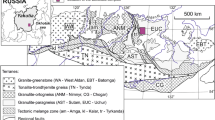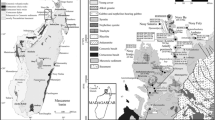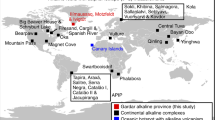Abstract
Geochronological data (∼1800 dates) have been analyzed by the probabilistic statistical analysis of samplings of different subalkaline and alkaline rocks through the whole of geological time. The distribution of five groups of subalkaline and alkaline rocks within the Late Archean-Phanerozoic are strictly controlled by mantle cycles, which were distinguished from data on the upper mantle magmatic rocks. Since high alkali rocks are plume related, their universal participation in each of the revealed mantle cycles emphasizes the importance of this magmatism in the evolution of the crustal-mantle system. The initial Sr and Nd isotope ratios are subdivided into two groups: with mantle and crustal signatures. Mantle isotope ratios are typically observed throughout the entire geological interval of dated rocks, while the role of crustal isotope signatures increases from the Archean to Phanerozoic, reflecting the increasing the role of fluids and crustal rocks in the magmatic processes during the generation of mantle magmas and their consolidation in the crust. Since alkaline magmatic sources are formed during mantle metasomatism, which enriched the magma generation zones in incompatible elements, the repeated occurrence of this process in separate mantle zones may have lead to the anomalous accumulation of these elements, which should be reflected in the alkaline magmas.
Similar content being viewed by others
References
L. N. Kogarko, “Alkaline Magmatism in the Early History of the Earth,” Petrologiya 6(3), 251–258 (1998) [Petrology 6 (3), 230–236 (1998)].
L. N. Kogarko and V. E. Khain, “Alkaline Magmatism in the Earth’s History: A Geodynamic Interpretation,” Dokl. Akad. Nauk 37(5), 679–688 (2001) [Dokl. Earth Sci. 377A (3), 359–361 (2001)].
K. C. Condie, “Episodic Continental Growth and Supercontinents: A Mantle Avalanche Connection,” Earth Planet. Sci. Lett. 163, 97–108 (1998).
R. E. Ernst, K. L. Buchan, T. D. West, and H. C. Palmer, “Diabase (Dolerite) Dyke Swarms of the World: First Edition,” Geol. Surv. Can. Open File, No. 3241 (1996).
L. B. Yale and S. J. Carpenter, “Large Igneous Provinces and Giant Dike Swarms: Proxies for Supercontinent Cyclicity and Mantle Convection,” Earth Planet. Sci. Lett. 163, 109–122 (1998).
Yu. A. Balashov and V. N. Glaznev, “The Impact of Plume Magmatism on the Dynamics of Precambrian Crust Formation,” Dokl. Akad. Nauk 395(2), 78–81 (2004) [Dokl. Earth Sci. 395 (2), 170–173 (2004)].
A. Streckeisen, “Classification and Nomenclature of Volcanic Rocks, Lamprophyres, Carbonatites, and Metilitic Rocks: Recommendations and Suggestions of the IUGS Subcommission on the Systematics of Igneous Rocks,” Geology 7, 331–335 (1979).
A Classification of Igneous Rocks and Glossary of Terms, Ed. by S. V. Efremova (Nedra, Moscow, 1997) [in Russian].
L. N. Kogarko, G. Kurat, and T. Ntaflos, “Carbonate Metasomatism of the Oceanic Mantle beneath Fernando de Noronha Island, Brazil,” Contrib. Mineral. Petrol. 140, 577–587 (2001).
V. Courtillot, A. Davaille, J. Besse, and J. Stock, “Three Distinct Types of Hotspots in the Earth’s Mantle,” Earth Planet. Sci. Lett. 205, 295–308 (2003).
S. R. Hart, E. H. Hauri, L. A. Oschmann, and J. A. Whitehead, “Mantle Plumes and Entrainment: Isotopic Evidence,” Science 256, 517–520 (1992).
F. Corfu, S. L. Jackson, and R. H. Sutcliffe, “U-Pb Ages and Tectonic Significance of Late Archean Alkalic Magmatism and Nonmarine Sedimentation: Timiskaming Group, Southern Abitibi Belt, Ontario,” Can. J. Earth Sci. 28, 489–503 (1991).
G. R. Tilton and K. Bell, “Sr-Nd-Pb Isotope Relationships in Late Archean Carbonatites and Alkaline Complexes: Applications to the Geochemical Evolution of Archean Mantle,” Geochim. Cosmochim. Acta 58(15), 3145–3154 (1994).
A. A. Arzamastsev, F. Bea, L. V. Arzamastseva, and P. Montero, “Paleozoic Plume-Lithosphere Interaction in the Northeast Baltic Shield: REE in Rocks and Minerals of Kola Intrusions as Indicators of Alkaline Melt Evolution,” in Proceedings of the II International Seminar “Deep Magmatism, Magmatic Sources, and Plume Problems (Irkutsk, 2002), pp. 54–86 [in Russian].
S. P. Turner, D. W. Peate, C. J. Hawkesworth, and M. S. M. Mantovani, “Chemical Stratigraphy of the Parana Basalt Succession in Western Uruguay: Further Evidence for the Diachronous Nature of the Parana Magma Types,” J. Geodynamics 28, 459–469 (1999).
A. R. Basu, P. R. Renne, D. K. Gupta, et al., “Early and Late Alkali Igneous Pulses and a High-3He Plume Origin for the Decan Flood Basalts,” Science 261, 902–906 (1993).
I. N. Tolstikhin, I. L. Kamensky, B. Marty, et al., “Rare Gas Isotopes and Parent Elements in Ultrabasic-Alkaline Carbonatite Complexes, Kola Peninsula: Identification of Lower Mantle Plume Component,” Geochim. Cosmochim. Acta 66(5), 881–901 (2002).
A. D. Brandon, M. D. Norman, R. J. Walker, and J. W. Morgan, “186Os-187Os Systematics of Hawaiian Picrites,” Earth Planet. Sci. Lett. 174, 25–42 (1999).
U. Schärer, F. Corfu, and D. Demaiffe, “U-Pb and Lu-Hf Isotopes in Baddeleyite and Zircon Megacrysts from the Mbuji-Mayi Kimberlite: Constraints on the Subcontinental Mantle,” Chem. Geol. 143(1–2), 1–16 (1997).
L. Kerschhofer, U. Schärer, and A. Deutsch, “Evidence for Crystals from the Lower Mantle: Baddeleyite Megacrysts of the Mbuji-Mayi Kimberlite,” Earth Planet. Sci. Lett. 179(2), 219–225 (2000).
Yu. A. Balashov and V. N. Glaznev, “Endrogenic Cycles in the Crust-Forming Problem,” Geokhimiya 44(2), 1–12 (2006) [Geochem. Int. 44 (2), 109–117].
J. Blichert-Toft, N. T. Arndt, and J. N. Luden, “Precambrian Alkaline Magmatism,” Lithos 37(1), 97–111 (1996).
S. K. Simakov, “The Clinopyroxene Barometry of Mantle Peridotites: Implication for Diamond Evaluation Potential,” Dokl. Akad. Nauk 376(6), 801–803 (2001) [Dokl. Earth Sci. 377 (2), 201–203 (2001)].
H. L. Allsopp, J. W. Bristow, C. B. Smith, et al., “A Summary of Radiometric Dating Methods Applicable to Kimberlites and Related Rocks,” in Kimberlites and Related Rocks: 1. Their Composition Occurrence, Origin, and Emplacement, Ed. by J. Ross, A. L. Jaques, et al., Geol. Soc. Austral. Spec. Publ., No. 14, 343–368 (1986).
P. D. Kinny, B. J. Griffin, L. M. Heaman, et al., “SHRIMP U-Pb Ages of Perovskite from Yakutian Kimberlites,” Russ. Geol. Geophys. 38(1), 97–105 (1997).
D. R. Nelson, A. F. Trendall, and W. Altermann, “Chronological Correlations between the Pilbara and Kaapvaal Cratons,” Precambrian Res. 97, 165–189 (1999).
S. L. Kamo and D. W. Davis, “Reassessment of Archean Crust Development in the Barberton Mountain Land, South Africa, Based on U-Pb Dating,” Tectonics 13(1), 167–192 (1994).
E. V. Tabuns, E. B. Sal’nikova, V. P. Kovach, et al., “Late Archean Age of Ultrapotassium Rocks in the Ukduska Massif, Aldan Shield: Evidence from U-Pb Studies of Single Zircon Grains,” in Proceedings of the II Russian Conference on Isotopic Geochronology (St. Petersburg, 2003), pp. 492–494 [in Russian].
G. B. Kiviets and D. Phillips, “40Ar/39Ar Laser Probe Analyses of K-bearing Titanates from Kimberlites,” in Abstracts of Papers of ICOG-9 (Beijing, 1998), p. 65.
R. T. Pidgeon, C. B. Smith, and C. M. Fanning, “Kimberlite and Lamproite Emplacement Ages in Western Australia,” in Kimberlites and Related Rocks: 1. Their Composition Occurrence, Origin, and Emplacement, Ed. by J. Ross, A. L. Jaques, et al., Geol. Soc. Austral. Spec. Publ., No. 14, 369–381 (1986).
A. P. Nutman and M. T. Rosing, “SHRIMP U-Pb Zircon Geochronology of the Late Archean Ruinneesset Syenite, Skieldungen Alkaline Province, Southeast Greenland,” Geochim. Cosmochim. Acta 58, 3515–3518 (1994).
Yu. A. Balashov, F. P. Mitrofanov, and V. V. Balagansky, “New Geochronological Data on Archean Rocks of the Kola Peninsula,” in Correlation of Precambrian Formations of the Kola-Karelian Region and Finland (Apatity, 1992), pp. 13–34.
T. B. Bayanova, F. P. Mitrofanov, R. M. Galimzyanova, and N. V. Levkovich, “Archean Age of the Alkaline Granite from the Belye Tundry Massif, Kola Peninsula,” Dokl. Akad. Nauk 369(6), 806–808 (1999) [Dokl. Earth Sci. 369A (9), 1381–1383 (1999)].
F. P. Mitrofanov, D. R. Zozulya, T. B. Bayanova, and N. V. Levkovich, “The World’s Oldest Anorogenic Alkali Granitic Magmatism in the Keivy Structure on the Baltic Shield,” Dokl. Akad. Nauk 374(2), 238–241 (2000) [Dokl. Earth Sci. 374 (7), 1145–1148 (2000)].
N. M. Kudryashov and M. N. Petrovskii, “Isotopic Age of Lamprophyres in the Kolmozero-Voron’ya Greenstone Belt,” in Proceedings of the XI Conference of Young Scientists “The Geology and Geoecology of Fennoscandia, Northwestern and Central Russia” (Petrozavodsk, 2000), pp. 36–38 [in Russian].
D. A. Wyman, R. Kerrich, and A. Polat, “Assembly of Archean Craton Mantle Lithosphere and Crust: Plume-Arc Interaction in the Abitibi-Wawa Subduction-Acretion Complex,” Precambrian Res. 115, 37–62 (2002).
V. R. Vetrin, I. L. Kamenskii, T. B. Bayanova, et al., “Melanocratic Nodules in Alkaline Granites of the Ponoiskii Massif, Kola Peninsula: A Clue to Petrogenesis,” Geokhimiya, No. 11, 1178–1190 (1999) [Geochem. Int. 37 (11), 1061–1072 (1999)].
Yu. A. Balashov, D. R. Zozulia, and M. J. Timmerman, “Archean Peralkaline Granites of the Kola Peninsula, Russia,” in Abstracts of Papers of ICOG-9 (Bejing, 1998), p. 5.
M. V. Mints, V. N. Glaznev, A. N. Konilov, et al., The Lower Precambrian of Northeast Baltic Shield: Paleogeodynamics, Structure, and Evolution of Continental Crust (Nauchnyi Mir, Moscow, 1996) [in Russian].
I. D. Batieva, The Petrology of Alkaline Granitoids in the Kola Peninsula (Nauka, Leningrad, 1976) [in Russian].
A. N. Zavaritskii, Igneous Rocks (Akad. Nauk SSSR, Moscow, 1961) [in Russian].
B. A. Yudin, Gabbro-Labradorite Association in the Kola Peninsula and Its Metallogeny (Nauka, Leningrad, 1980) [in Russian].
A Predictive Model of the Deep Structure in the Zone of Geophysical Profile 2 in East Kola Peninsula, Ed. by F. P. Mitrofanov (Geol. Inst. Kol’sk. Nauchn. Tsentr Ross. Akad. Nauk, Apatity, 2000) [in Russian].
K. C. Condie, “The Supercontinent Cycle: Are There Two Patterns of Cyclicity?,” J. Afr. Earth Sci. 53, 179–183 (2002).
A. B. Blaxland, O. Van Breemen, and A. Steenfelt, “Age and Origin of Agpaitic Magmatism at Ilimaussaq, South Greenland: Rb-Sr Study,” Lithos 9, 31–38 (1976).
V. I. Gerasimovskii, The Geochemistry of the Ilimaussak Alkaline Massif (Nauka, Moscow, 1969) [in Russian].
L. N. Kogarko, U. Kramm, and B. Granert, “New Data on the Age and Genesis of Alkaline Rocks of the Lovozero Massif,” Dokl. Akad. Nauk SSSR 268(4), 970–973 (1983).
V. I. Gerasimovskii, V. P. Volkov, L. N. Kogarko, et al., The Geochemistry of Lovozero Alkaline Massif (Nauka, Moscow) [in Russian].
A. A. Arzamastsev, F. Bea, V. N. Glaznev, et al., “The Kola Alkaline Province in the Paleozoic: The Composition of Initial Mantle Magmas and the Conditions of Magma Generation,” Ross. Zh. Nauk o Zemle 3(1), 3–24 (2001).
Yu. A. Balashov, The Isotopic Geochemical Evolution of the Earth’s Mantle and Crust (Nauka, Moscow, 1985) [in Russian].
A. W. Hofmann, “Chemical Differentiation of the Earth: The Relationship between Mantle, Continental Crust, and Oceanic Crust,” Earth Planet. Sci. Lett. 90, 297–314 (1988).
W. F. McDonough and S.-S. Sun, “The Composition of the Earth,” Chem. Geol. 120, 223–253 (1995).
D. J. De Paolo and G. J. Wasserburg, “Inferences about Magma Sources and Mantle Structure from Variations of 143Nd/144Nd,” Geophys. Rev. Lett. 3, 743–746 (1976).
S. R. Carter, N. M. Evensen, P. J. Hamilton, and R. K. O’Nions, “Continental Volcanics Derived from Enriched and Depleted Source Regions: Nd-and Sr-Isotope Evidence,” Earth Planet. Sci. Lett. 37, 401–408 (1978).
S. L. Goldstein, R. K. O’Nions, and P. J. Hamilton, “A Sm-Nd Study of Atmospheric Dust and Particulates from Major River Systems,” Earth Planet. Sci. Lett. 70, 221–236 (1984).
Yu. A. Balashov, “Pulsation Model of Mantle Differentiation: Evolution, Geochronological, Geochemical, Petrologic, and Geodynamic Implications,” in Proceedings of 30th International Geological Congress (1997), Vol. 1, pp. 79–95.
K. Bell and J. Blenkinsop, “Neodymium and Strontium Isotope Geochemistry of Carbonatites,” in Carbonatites: Genesis and Evolution, Ed. by K. Bell (Unwin Hyman, London, 1989), pp. 278–300.
D. R. Nelson, “Isotopic Characteristics of Potassic Rocks: Evidence for the Involvement of Subducted Sediments in Magma Genesis,” Lithos 28, 403–420 (1992).
F. Bea, A. Arzamastsev, P. Montero, and L. Arzamastaeva, “Anomalous Alkaline Rocks of Soustov, Kola: Evidence of Mantle-derived Metasomatic Fluids Affecting Crustal Materials,” Contrib. Mineral. Petrol. 140, 554–566 (2001).
Yu. A. Balashov, “Isotopic Heterogeneity of the Earth’s Upper Mantle,” in Geochemistry of Radiogenic Isotopes during the Early Evolution of the Earths, Ed. by Yu. A. Shukolyukov (Nauka, Moscow, 1983), pp. 77–96 [in Russian].
M. Stein and A. W. Hofmann, “Mantle Plumes and Episodic Crustal Growth,” Nature 372, 63–68 (1994).
Yu. A. Kostitsyn, “Is the Sm-Nd Isotopic System of the Mantle Identical to That of Chondrites?,” in Proceedings of the Year Session “The Geochemistry of Igneous Rocks: Alkaline Magmatism of the Earth” (Moscow, 2002), pp. 53–54 [in Russian].
Yu. A. Kostitsyn, “Sm-Nd, Lu-Hf, and Rb-Sr Isotopic Systems of the Primitive Mantle,” in Proceedings of the II Russian Conference on Isotopic Geochronology “Role of Isotopic Geochronology in the Solution of Geodynamic and Ore Formation Problems” (Tsentr Inform. Kul’t., St. Petersburg, 2003), pp. 213–216 [in Russian].
Yu. A. Kostitsyn, “Terrestrial and Chondritic Sm-Nd and Lu-Hf Isotopic Systems: Are They Identical?,” Petrologiya 12(5), 451–466 (2004) [Petrology 12 (5), 397–411 (2004)].
Yu. D. Pushkarev, “The Oldest Geochronological Boundary in the Crust-Mantle-Core Evolution and the Bulk Composition of Silicic Earth,” in Proceedings of the II Russian Conference on Isotopic Geochronology “Role of Isotopic Geochronology in Solution of Geodynamic and Ore Formation Problems” (Tsentr Inform. Kul’t., St. Petersburg, 2003), pp. 376–380 [in Russian].
A. W. Hofmann, “Mantle Geochemistry: The Message from Ocean Volcanism,” Nature 385, 219–229 (1997).
D. G. Pearson, “The Age of Continental Roots,” Lithos 48, 171–194 (1999).
Author information
Authors and Affiliations
Corresponding author
Additional information
Original Russian Text © Yu.A. Balashov, V.N. Glaznev, 2006, published in Geokhimiya, 2006, No. 3, pp. 309–321.
Rights and permissions
About this article
Cite this article
Balashov, Y.A., Glaznev, V.N. Cycles of alkaline magmatism. Geochem. Int. 44, 274–285 (2006). https://doi.org/10.1134/S0016702906030050
Received:
Issue Date:
DOI: https://doi.org/10.1134/S0016702906030050




